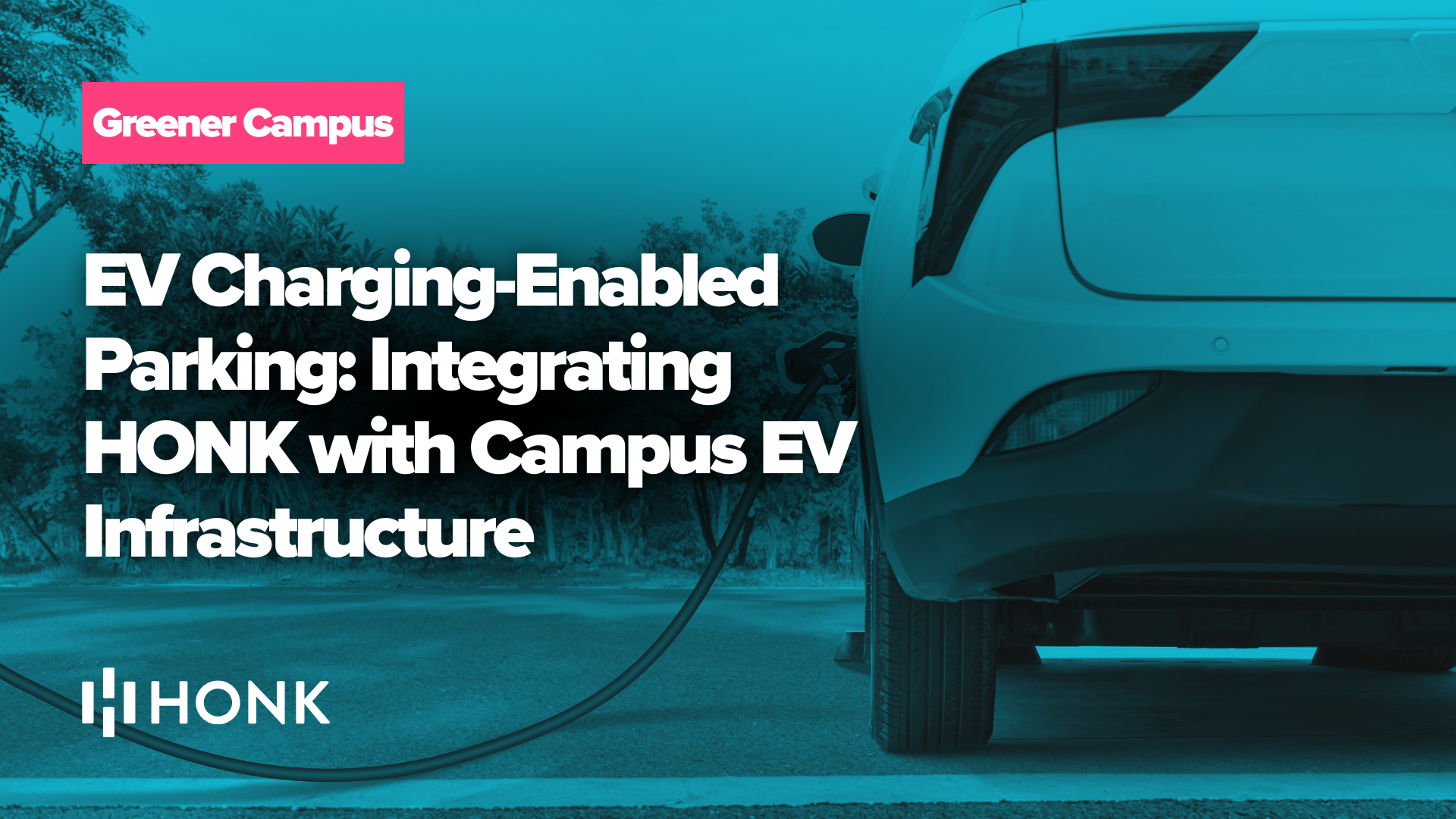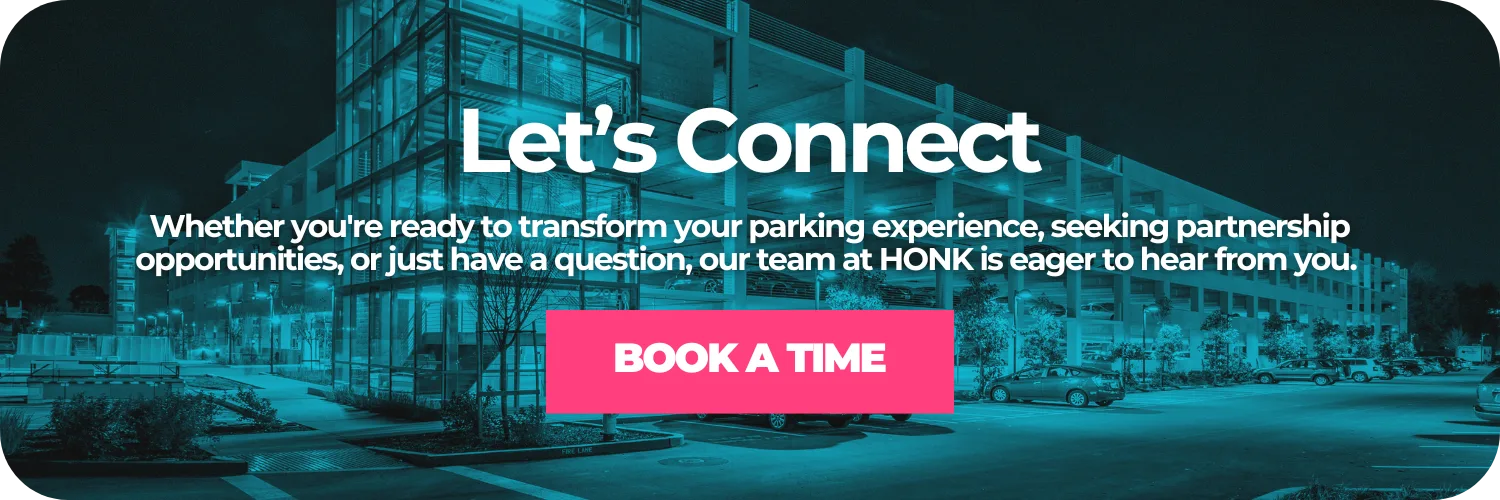The rapid rise of electric vehicles (EVs) is transforming how campuses across North America think about mobility, sustainability, and parking. Universities and colleges are not just places of learning—they are thriving ecosystems with thousands of daily commuters, including students, faculty, staff, and visitors. As EV adoption accelerates, the pressure on institutions to provide reliable, convenient charging infrastructure has never been greater. But installing charging stations is only half the battle. Without intelligent management, EV parking can become a source of frustration for drivers, operators, and sustainability officers alike.
That’s where HONK comes in. By integrating EV charging into a seamless digital parking experience, campuses can take control of payments, reservations, and data analytics—while creating an environment that encourages sustainable transportation choices. In this blog, we’ll explore how EV charging-enabled parking works with HONK, why it matters for campus mobility, and how universities can future-proof their infrastructure.
The New Reality of EVs on Campus
According to the International Energy Agency, more than 14 million electric cars were sold in 2023 alone, and the global EV fleet is projected to reach 350 million by 2030. In the United States, EV adoption has surged to the point where one in every eight new vehicles sold is now electric. For younger generations—especially students—the appeal of EVs is even stronger, driven by climate awareness and the desire to reduce reliance on fossil fuels.
College campuses have always been microcosms of societal change. They were among the first to embrace recycling programs, green buildings, and bike-share systems. Today, they are on the frontlines of EV adoption. Yet most campuses were not designed with EVs in mind. Parking lots built decades ago lack the electrical infrastructure to support widespread charging, and operators often struggle to manage limited charging stations fairly and efficiently.
A student or professor who finds every charger occupied—or worse, blocked by a non-EV—faces unnecessary stress. Facilities managers, meanwhile, face pressure to expand charging availability while balancing costs. Without smart systems in place, EV infrastructure risks becoming a liability rather than a showcase of sustainability leadership.
Beyond Charging Hardware: Why Management Matters
Installing EV chargers may seem like a straightforward solution, but hardware is only part of the equation. The real challenge lies in management—ensuring chargers are available when needed, used fairly, and supported by clear policies and reliable payments.
For example, consider these scenarios:
- A visitor books a spot in advance for a campus event, only to arrive and find the EV charger taken.
- A commuter plugs in for the day, monopolizing a charger long after their battery is full.
- Facilities staff need to report on sustainability metrics, but lack visibility into actual charging usage.
Without digital integration, these pain points are inevitable. By contrast, pairing EV hardware with HONK’s digital parking platform transforms charging into a smooth, user-friendly experience that benefits drivers and administrators alike.
HONK’s Role in EV Charging-Enabled Parking
HONK has already revolutionized parking with contactless payments and digital permits, eliminating paper tickets and manual enforcement headaches. Extending these capabilities to EV infrastructure is a natural evolution. Here’s how HONK’s system empowers campuses to manage EV charging seamlessly:
Unified Payments
Drivers can pay for EV charging directly through HONK’s app or mobile web, the same way they already pay for regular parking. Instead of juggling multiple apps or payment systems, everything flows through a single, intuitive platform.
Real-Time Reservations
HONK enables users to reserve EV-enabled spots in advance, guaranteeing availability upon arrival. This feature is invaluable for students commuting from off-campus housing, faculty with tight teaching schedules, or visitors attending large events.
Dynamic Pricing
Campuses can set pricing policies that reflect actual usage. For example, they may charge a premium during peak hours, offer discounted rates for overnight charging, or apply idle fees when a vehicle overstays after being fully charged.
Analytics & Reporting
Through HONK’s dashboard, administrators gain deep insights into usage patterns—such as average charging session length, energy consumption, and turnover rates. These metrics help sustainability officers demonstrate progress toward institutional goals like carbon neutrality while giving operators data to plan future infrastructure investments.
Seamless Enforcement
By linking license plate recognition (LPR) to digital permits, enforcement teams can quickly identify vehicles that are overstaying, parked without authorization, or blocking EV spots. This reduces conflict and ensures fair access.
The Student & Faculty Experience
For campus communities, convenience is everything. Students and staff don’t want to worry about whether a charger will be available, how to pay, or if their spot is secure. With HONK’s integrated platform:
- Students can reserve a charging spot for the day, pay with a credit card or mobile wallet, and get real-time notifications when their session is complete.
- Faculty and staff with long commutes can purchase subscription passes that include EV charging access, eliminating daily hassles.
- Visitors attending sporting events or conferences can pre-book both parking and charging through a single transaction.
By streamlining the experience, HONK makes EV ownership practical on campus—encouraging adoption and supporting broader sustainability commitments.
Addressing Campus Pain Points
Let’s look at how HONK solves some of the most common challenges universities face when deploying EV infrastructure:
- Limited chargers: Reservation features reduce uncertainty and wasted time, while dynamic pricing discourages “camping” at chargers.
- Budget constraints: HONK’s revenue management tools help campuses recover costs by setting appropriate rates and maximizing utilization.
- Sustainability reporting: Analytics provide clear, actionable data to showcase environmental impact.
- Policy enforcement: Digital permits tied to LPR minimize misuse and streamline monitoring.
By integrating charging into existing parking operations, universities can avoid silos, reduce administrative burden, and create a cohesive mobility ecosystem.
A Sustainability Showcase
Campuses are increasingly judged by their climate action commitments. Institutions like the University of California system and Arizona State University have ambitious carbon neutrality targets, with transportation emissions often representing a major obstacle.
EV charging infrastructure—when managed effectively—offers an opportunity to demonstrate progress. By using HONK to measure usage and emissions reductions, universities can publish transparent reports showing how their investments contribute to cleaner air, lower greenhouse gases, and reduced congestion. This data also supports applications for grants and partnerships, reinforcing the campus’s role as a leader in sustainability.
Preparing for the Future of Mobility
The next decade will bring even greater changes in campus mobility. Autonomous vehicles, vehicle-to-grid energy systems, and shared EV fleets are already on the horizon. By adopting digital EV parking management today, universities set the stage for these future innovations.
HONK’s flexible, API-driven architecture means campuses can integrate new technologies—whether it’s smart grid energy management or autonomous shuttle fleets—without overhauling their parking systems. The key is starting with a strong foundation: a platform that unifies payments, reservations, and data.
Case Study: A Hypothetical Campus Deployment
Consider a mid-sized university with 25,000 students and a growing population of EV drivers. The administration installs 50 charging stations across three lots but quickly runs into problems: demand outstrips supply, drivers complain about “charger squatters,” and administrators struggle to track usage.
By integrating HONK:
- Students can reserve spots and get text alerts when charging is complete.
- Faculty purchase annual permits that include tiered charging privileges.
- Administration tracks metrics showing 92% utilization during peak hours and a 30% reduction in idle time.
- Sustainability officers quantify carbon savings equivalent to removing 500 gasoline cars from campus roads annually.
The result: fewer complaints, stronger sustainability performance, and a positive return on infrastructure investment.
Building a Smarter, Greener Campus with HONK
EVs are not a passing trend—they are the future of transportation. For universities and colleges, the challenge is not whether to invest in charging infrastructure, but how to do so intelligently. By integrating EV charging with HONK’s proven digital parking platform, campuses can deliver a seamless experience for drivers, unlock powerful analytics, and align mobility operations with long-term sustainability goals.
Students, faculty, and visitors expect modern, digital-first solutions that reflect their values. HONK empowers campuses to meet these expectations, transforming parking from a daily frustration into a sustainability showcase.
The road to carbon neutrality runs through smarter mobility, and EV charging-enabled parking is a critical milestone along that journey. With HONK, campuses can ensure that milestone is met with efficiency, fairness, and vision.





